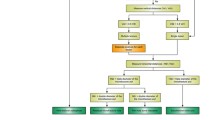Abstract
Objectives
The most important decision in distraction osteogenesis is the timing of fixator removal. Various methods have been tried, such as radiographic appearance of callus and bone mineral density (BMD) assessment, but none has acquired gold standard status. The purpose of this study was to develop another objective method of assessment of callus stiffness to help clinicians in taking the most important decision of when to remove the fixator.
Materials and methods
We made a retrospective study of 70 patients to compare the BMD ratio and pixel value ratio. These ratios were calculated at the time of fixator removal, and Pearson’s coefficient of correlation was used to show the comparability. Inter- and intra-observer variability of the new method was also tested.
Results
Good correlation was found between BMD ratio and pixel value ratio, with a Pearson’s coefficient of correlation of 0.79. The interobserver variability was also low, with high intra-observer reproducibility, suggesting that this test was simple to perform.
Conclusion
Pixel value ratio is a good method for assessing callus stiffness, and it can be used to judge the timing of fixator removal.



Similar content being viewed by others
References
Maffulli N, Hughes T, Fixsen JA. Ultrasonographic monitoring of limb lengthening. J Bone Joint Surg Br 1992; 74: 130–132.
Minty I, Maffulli N, Hughes TH, Shaw DG, Fixsen JA. Radiographic features of limb lengthening in children. Acta Radiol 1994; 35: 555–559.
Maffulli N, Cheng JCY, Sher A, Ng BKW, Ng E. Bone mineralization at the callotasis site after completion of lengthening bone 1999; 25: 333–338.
Salmas MG, Nikiforidis G, Sakellaropoulos G, Kosti P, Lambiris E. Estimation of artifacts induced by the Ilizarov device in quantitative computed tomographic analysis of tibiae. Injury 1998; 29: 711–716.
Minematsu K, Tsuchiya H, Taki J, Tomita K. Blood flow measurement during distraction osteogenesis. Clin Orthop 1998; 347: 229–235.
Eyres KS, Bell MJ, Kanis JA. New bone formation during leg lengthening. Evaluated by dual energy X-ray absorptiometry. J Bone Joint Surg Br 1993; 75: 96–106.
Eyres KS, Bell MJ, Kanis JA. Methods of assessing new bone formation during leg lengthening. Ultrasonography, by dual energy x-ray absorptiometry and radiography compared. J Bone Joint Surg Br 1993; 75: 358–364.
Guichet JM, Braillon P, Bodenreider O, Lascombes P. Periosteum and bone marrow in bone lengthening: A DEXA quantitative evaluation in rabbits. Acta Orthop Scand 1998; 69: 527–531.
Tselentakis G, Owen PJ, Richardson JB, et al. Fracture stiffness in callotasis determined by dual-energy X-ray absorptiometry scanning. J Pediatr Orthop B 2001; 10: 248–254.
De Backer AI, Mortelé KJ, De Keulenaer BL. Picture archiving and communication system—part one: filmless radiology and distance radiology (review). JBR-BTR 2004; 87: 234–421.
Kabachinski J. DICOM: key concepts—part I. Biomed Instrum Technol 2005; 39: 214–216.
Passadore DJ, Isoardi RA, Ariza PP, Padin C. Use of a low-cost, PC based image review workstation at a radiology department. J Digit Imaging 2001; 14 [2 Suppl 1]: 222–223.
Dugas M, Trumm C, Stabler A, et al. Case-oriented computer-based training in radiology: concept, implementation and evaluation. BMC Med Educ 2001; 1: 5–9.
Swaton N. Learn from experience: insights of 200+ PACS customers. Radiol Manage 2002; 24: 22–27.
Shim JS, Chung KH, Ahn JM. Value of measuring bone density serial changes on a picture archiving and communication system (PACS) monitor in distraction osteogenesis. Orthopedics 2002; 25: 1269–1272.
Ilizarov GA. Clinical application of the tension-stress effect for limb lengthening. Clin Orthop 1990; 250: 8–25.
Fischgrund J, Paley D, Suter C. Variables affecting time to bone healing during limb lengthening. Clin Orthop 1994; 301: 31–37.
Starr KA, Fillman R, Raney EM. Reliability of radiographic assessment of distraction osteogenesis site. J Pediatr Orthop 2004; 24: 26–29.
Young JW, Kovelman H, Resnik CS, Paley D. Radiologic assessment of bones after Ilizarov procedures. Radiology 1990; 177:89−93.
Author information
Authors and Affiliations
Corresponding author
Additional information
The authors certify that they have no commercial associations that might pose a conflict of interest in connection with the submitted article. No benefits in any form have been received or will be received from a commercial party related directly or indirectly to the subject of this article.
Rights and permissions
About this article
Cite this article
Hazra, S., Song, HR., Biswal, S. et al. Quantitative assessment of mineralization in distraction osteogenesis. Skeletal Radiol 37, 843–847 (2008). https://doi.org/10.1007/s00256-008-0495-7
Received:
Revised:
Accepted:
Published:
Issue Date:
DOI: https://doi.org/10.1007/s00256-008-0495-7




